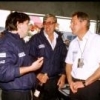Stirling Moss refers to the oil injectors on the Mercedes 300SLR in
My cars, my career when writing of the Buenos Aires
Formule Libre race (where they ran W196 single seaters with the 300SLR engine) he says:
We had some trouble with a locking front drum brake - inboard of course on those early-season long-wheelbase cars - and since there was no time to dtrip it between the heats, its linings were simply squirted with oil. Obviously braking was diminished, but at least it cured the locking, There was a servo in the system anyway, so very high pressuyres could be applied, which would wear down the high-spots in both the brake lining and the drum liner as as the heat burned the oil away. From this Argentine expedient Mercedes rapidly developed the push-button brake-oiling system which subsequently handled locking brakes on the 300SLRs.
Then in the section on the 300SLR at Le Mans he says:
Another Tweak - developed from the temporary expedient in the Argentinian Libre race at the beginning of the year - was a row of four cockpit plungers to squirt oil into locking drum brakes, on the basis that no brake at all was better than one locked up.
As this comes under Le Mans, it implies that these were not fitted for the Mille Miglia. This is borne out by Denis Jenkinson who says in
A story of Formula 1 that by the end of the race the car's brake linings had worn away to the extent that the front brakes were metal to metal and the alloy of the shoes had worn measurably. He refers to a front brake tending to grab which spun the car into a ditch. This suggests that the oil plungers weren't fitted.
My apologies for wandering away from the central topic of driver-adjustable brake balance.













